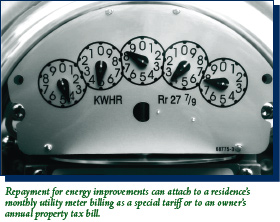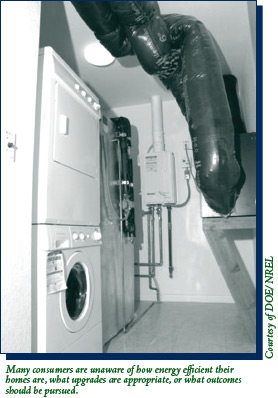November 2009
In this Issue
Paying for Energy Infrastructure Upgrades
Powered by the Sun
The Health of Our Cities’ Housing
Reevaluating Affordable Housing Policy Tools
In the next issue of ResearchWorks
Paying for Energy Infrastructure Upgrades
The residential sector accounts for 21 percent of all energy used in the United States, but homes consume as much as 30 percent more energy than what’s required for comfort and affordability. Newly constructed homes feature energy-efficient technologies that reduce this consumption, but much of the nation’s housing stock, with a median age of 36 years, lacks this advantage.1

Consumers are generally uncertain about the steps necessary to improve their homes’ energy efficiency. Most homeowners are unaware of just how energy (in)efficient their homes are, what upgrades would be appropriate, or what outcomes to target. The typical homeowner often feels ill-equipped to make the necessary upfront investment and ill-prepared to evaluate the short- and long-term savings and benefits. A shortage of contractors trained in the most energy-efficient design and installation methods further complicates the matter.
Retrofitting an existing home with energy-efficient features can be expensive — one reason for offering federal energy tax credits and other financial incentives to homeowners who make “green” improvements. Owners of rental properties who invest in efficiency upgrades must be willing to do so without immediately realizing the benefits, because many tenants pay their own utility bills and therefore are the ones to benefit immediately and directly from the savings. The payoff for rental property owners lies in the future, with the appeal to tomorrow’s renters of an energy-efficient home with lower utility bills.
One big challenge is to find ways to help low-income households with the highest energy cost burdens, with poor credit, and/or those who rent. Utilities, states, and regional organizations have all sponsored programs to stimulate consumer investment in energy-efficiency improvements, with mixed success. Many programs are small and have had little impact. Some struggle to ensure that their energy savings actually exceed scheduled repayment amounts. Others support basic weatherization and lighting improvements but would produce much larger savings with more comprehensive energy retrofits. Utility firms that participate have sometimes had difficulty making the necessary adjustments.2
To examine the types of financial mechanisms available for making energy savings accessible to low- and moderate-income families, the Energy and Resources Group (ERG) at the University of California at Berkeley recently reviewed 18 different types of programs in the United States and Canada that help finance residential energy-efficient improvements. Options already exist for current homeowners and new homebuyers in the form of favorable terms in mortgage refinancing to pay for energy upgrades or energy improvement mortgages, but ERG paid particular attention to on-bill financing programs that enable consumers to purchase and install energy-efficient products without incurring any upfront costs.3
 Tariffed installation programs (TIPs) and clean
energy municipal financing (CEMF) are two
programs that appeared to ERG to have the most
potential for addressing some of the aforementioned
problems. In the TIP model, energy improvements are
funded with bond sales, public funds, utilities, or other
sources of private capital. Repayment is scheduled by
attaching a monthly charge to a residence’s utility
meter as a special tariff paid by the occupant. This
monthly tariff is capped at less than the amount saved
from energy improvements, and it is spread over
a period that is shorter than the anticipated life of
the enhancements. CEMF for energy products and
their installation is funded through a bond issued by
the municipality. The homeowner repays this loan
through a special fee assigned to the property tax bill
over a period of 20 years. If the property sells during
that time, the new owner pays the remainder of
the loan in the same way — as part of the annual
property tax bill.
Tariffed installation programs (TIPs) and clean
energy municipal financing (CEMF) are two
programs that appeared to ERG to have the most
potential for addressing some of the aforementioned
problems. In the TIP model, energy improvements are
funded with bond sales, public funds, utilities, or other
sources of private capital. Repayment is scheduled by
attaching a monthly charge to a residence’s utility
meter as a special tariff paid by the occupant. This
monthly tariff is capped at less than the amount saved
from energy improvements, and it is spread over
a period that is shorter than the anticipated life of
the enhancements. CEMF for energy products and
their installation is funded through a bond issued by
the municipality. The homeowner repays this loan
through a special fee assigned to the property tax bill
over a period of 20 years. If the property sells during
that time, the new owner pays the remainder of
the loan in the same way — as part of the annual
property tax bill.
The Midwest Energy How$martSM pilot program in central and western Kansas is a demonstration of a TIP that lends money for energy-efficiency improvements like insulation, air sealing, and heating and cooling systems. The Kansas Housing Resources Corporation (a public source) and Midwest Energy (a private source) provide upfront capital at an interest rate of 4 percent for a repayment period of 15 years. Customers repay the loan by accepting a surcharge on their monthly utility bill of no more than 90 percent of the projected energy savings. The state’s regulatory commission reviewed and approved this new tariff.
Any electric or gas customer whose utility bills are current is eligible. When a rental property is involved, the property owner and the tenant must both agree to participate. Midwest Energy first conducts a comprehensive energy audit in the home, makes recommendations on improvements needed, and estimates the savings outcome. Customers who decide to proceed choose an approved contractor to do the work according to Midwest’s specifications, relieving the customer from having to make decisions about unfamiliar technologies. The utility pays the contractor after completing the work (only for the amount justified by energy savings) and adds the tariff to the customer’s monthly bill. Midwest also files a Uniform Commercial Code form with the county’s Register of Deeds for the obligation, letting potential buyers, brokers, or real estate agents know that the obligation exists and will transfer to the next owner. Before the end of the first year, 167 projects were approved with an average loan amount of $4,000.4
This illustration of a TIP shows how one community is attempting to make residential energy-efficient upgrades accessible and affordable to both renters and homeowners. Community planners and policymakers will be following the development of such energy retrofits in the interest of relieving the housing cost burden for many citizens, thus “greening” the nation’s housing and improving the environment.
1Joint Center for Housing Studies, The State of the Nation’s Housing 2009, p. 30, www.jchs.harvard.edu/publications/markets/ son2009/son2009.pdf; ENERGY STAR Program, “Financing Guidebook for Energy Efficiency Program Sponsors,” December 2007, www.energystar.gov/ia/home_improvement/downloads/ FinancingGuidebook.pdf, p. 3.
2ENERGY STAR Program, pp. 3–6.
3Merrian Fuller, Enabling Investments in Energy Efficiency: A Study of Energy Efficiency Programs That Reduce First-Cost Barriers in the Residential Sector, May 2009, http://uc-ciee.org/energyeff/ documents/resfinancing.pdf.
4Midwest Energy Services, How$martSM Program, www.mwenergy.com/energyservices.aspx.

